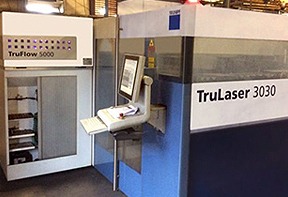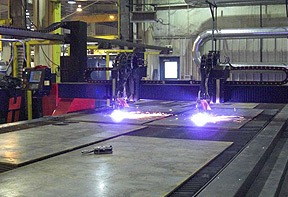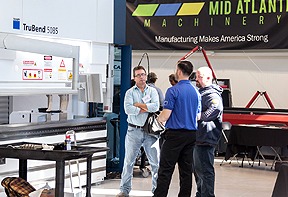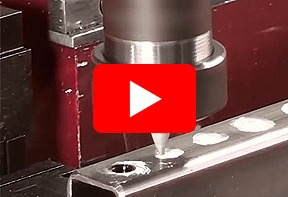Ask The Engineer- FAQ
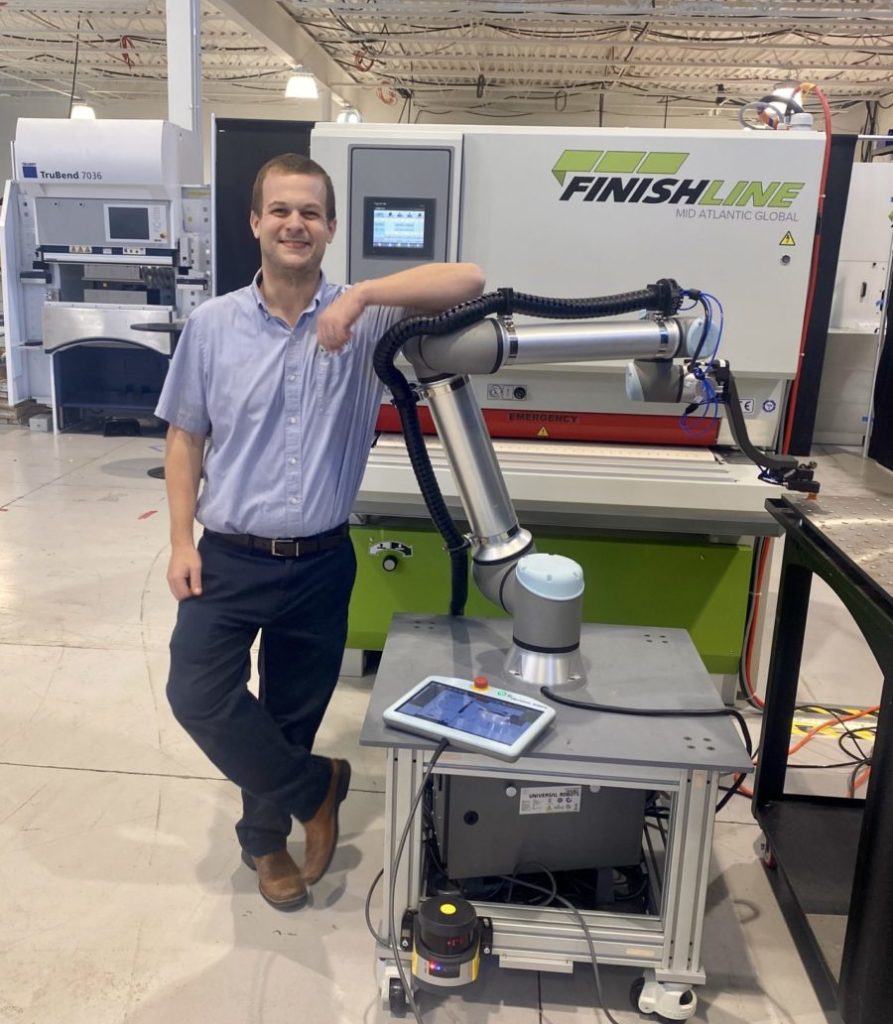
There are a lot of questions surrounding automation in the fabrication world and justifying machine tool robotic integration projects can seem risky without the proper guidance. To alleviate some concerns, we asked our in-house Application Engineer and automation expert Josh Mayse to help. Below are some of his answers to the most frequently asked questions that he hears when speaking to customers about robotics and machine tool integration.
We hope this article will answer some of your immediate questions on the topics of; Mid Atlantic Machinery Automation, the Press Brake Operator Package, Modular Integration, Safety Scanners, Robotic Programming, Gripper Technology, and more.
If you don’t see your question below or are interested in speaking with Josh about your specific application contact us today for an automation consultation.
- Why Mid Atlantic’s Cobot solutions?
The collaborative robot itself is a very versatile tool. The challenge becomes how to apply the tool to solve a specific industrial challenge. This is where Mid Atlantic Machinery’s Engineering sets us apart from the competition.
We have developed a standardized interface method to run a wide range of machine tools. This interface allows the robot to be integrated into different machine tools in minutes with the use of quick disconnect cord sets. After the robot can communicate with the machine the next challenge becomes gripping the parts. Mid Atlantic has patent applications for versatile multipurpose gripping systems that allow us to cover a wide variety of parts without developing an expensive custom, end of arm tool for every application or part.
We like to think of ourselves as fabrication process experts, and as a result, we understand the equipment as well as the robotics.
- Can your Press Brake Operator Package handle Large Parts?
Yes, the press brake operator package can be sold with any of the 4 Universal Robots collaborative robots. The family of robots includes the UR 3e, UR 5e, UR 10e, and UR16e which offer payloads of 3, 5, 10, and 16 kg respectively.
I preferred the Universal Robot 10e as it gives me the best ratio of payload to reach and with the robot outfitted with our fully loaded patented gripper technology it yields a good amount of effective payload for part handling. If you have larger or heavy parts that you want to bend, we can look at moving up to the 16e; However, you must keep in mind that moving up in the family does limit the reach of the robotic arm. There are also several ways we can optimize the program to support heavy parts, such as having the arm follow the part throughout the bend.
- What requirements for a press Brake to be integrated with this solution? Can it be fitted to a different brake other than a TRUMPF?
The only real requirement for the machine is that it bends and we’re able to repeat them fairly accurately. Once we can achieve that we can begin the process of robot integration.
In order for us to automate the brake, we must be able to get the transducer to properly stop the ram at a few positions throughout the bend. In order for the robot to manipulate the part we’d have to stop at three points; the clamping point, the bottom of the bend, and the end of the brake program.
Ultimately, it comes down to having a quality machine. You do not want to automate something that is only going to make incorrect and scrap parts faster.
- Can the robot be programmed for other applications?
Yes, The robot is capable of being programmed to perform a variety of activities. Some of the most common applications and applications that are out in the field are; Press brake operations, CNC machine tending, loading and unloading of Finishing equipment, Robotic Sanding, and Quality Inspection Equipment. If you’re interested in learning more about any of these particular applications contact Mid Atlantic Machinery to schedule a time for us to talk.
- Am I stuck having this robot automate only one of my machine tools?
No. Unlike automation of the past, the robot can be easily redeployed to many different tasks. The robot can be used for other applications that are considered to be collaborative without requiring caging. Some examples would be an adhesive application, palletizing, or loading and unloading parts on and off of finishing or inspection equipment.
A good example to illustrate this is a welding robot. In the past, the stationary, job-specific, robotic welder could only weld. If the robot didn’t have work the high dollar, capital investment asset sat unutilized. Today thanks to Mid Atlantic Machinery Automation and Universal Robots that same robot could be running a press brake or loading a CNC when not welding. This is due in part to the size of the collaborative robot, the 110V power supply, and the force and torque monitoring. With these built-in Universal Robot features, modularity and versatility are made possible.
- What safety features does the press brake robot package come with?
It is important to note that the robot is shipped as partly completed machinery according to 2006/42/EC. The Robot is considered to be collaborative, also known as force and torque limited, as shipped. However, when put into service operating a press brake the robot is no longer considered to be in a collaborative application. The robot will be moving at high speed with sharp sheet metal and therefore requires additional protection.
That’s why we’ve created a package that includes a two-zone, safety scanner that is performance level D per ISO 13849. The scanner has programmable zones that can be customized to the application. When the first zone is entered the robot reduces its speed to 250mm/s which is defined as an avoidable speed by OSHA. When the second zone, or the danger zone, is entered the robot stops. The robot can be set up to resume work once the scanner is cleared or wired to an acknowledgment button outside of the safety protected zone. Light curtains can also be used in combination with physical barriers or safety scanners as required per application.
At the completion of the project we’ll perform a full ISO/TS 15066 compliant risk assessment for collaborative robot cells, will which takes into account and mitigates any additional risk as necessary.
- Does the robot have a name?
Yes, Our robot is called Bender and has served us well. We know that as soon as you start working with your robot you’ll form the same appreciation and will give yours a name as well.
We hope this article helped you see how Mid Atlantic Machinery Automation can help bring your robotic integration ideas to reality. If any of your questions were not answered here and you would like to learn more, contact us today to schedule a meeting with Josh Mayse, our Application Engineering team, or Bender.





